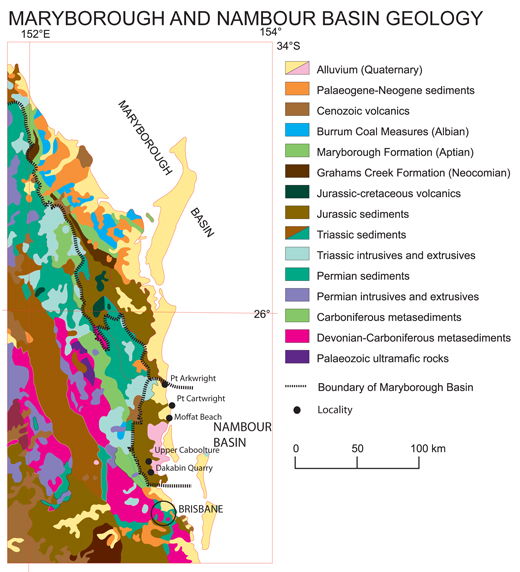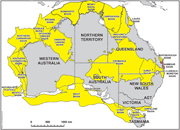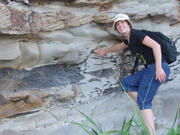Few palaeontological studies have been carried out on the Landsborough Sandstone apart from palynological analyses of stratigraphic borehole samples (summarized by McKellar 1993). In addition, Jones & de Jersey (1947) described equisetalean fossils from the “ Brighton beds" (Toarcian) — a fine-grained facies in the upper part of the Landsborough Sandstone. Pattemore (2000) described Knezourocarpon (=Palissya) cones from a claypit 2 km NNW of Narangba. Pattemore & Rigby (2005) described a scale-leafed conifer shoot and gymnospermous spur shoots (misinterpreted as cones) from this unit. Floras of roughly equivalent age have also been described from the Clarence-Moreton Basin to the southwest (Jansson et al. 2008). Turner et al. (2009) discussed the Landsborough Sandstone flora in the context of regional patterns in the evolution of the Australian biota.
To date, the Landsborough Sandstone has yielded only small assemblages of plant fossils and most records are of fossil wood. Silicified wood can be seen in many coastal rock platforms in the Nambour Basin(e.g., at Moffat Beach: see image). Well-preserved impressions of leaves and fertile organs are sparse. Nevertheless, the flora is significant because it represents one of the few records of the Early Jurassic vegetation from eastern Australia and provides insights into changes in the flora following the end-Triassic mass extinction.
NRM has relatively small collections of plant fossils from the Landsborough Sandstone.
These are mainly represented by:
1. Leaf and cone impressions from a disused claypit at Dakabin, now largely infilled as a refuse dump;
2. Silicified wood exposed in land cultivation near Morayfield-Upper Caboolture;
3. Silicified wood derived from road cuttings in the Glasshouse Mountains district; and
4. Silicified wood exposed in rock platforms on the Sunshine Coast (e.g. Pt Arkwright).

Map of southeast Queensland showing key fossil sites in relation to the broad-scale geology of the Maryborough and Nambour basins. Modified from Day et al., 1983.
References
Cranfield, L. C. and Schwarzbbck, H., 1976. Nambour Basin. In: Leslie, R. B., Evans, H. J.and Knight, C. L. (Eds.), Economic Geology of Australiaand Papua New Guinea. 3. Petroleum. Australasian Institute of Mining and Metallurgy, Melbourne, pp 450-452.
Day, R. W., Whitaker, W. G., Murray, C. G., Wilson, I. H. and Grimes, K. G., 1983. Queensland Geology. Geological Survey of Queensland Publication 383, 1-194.
Jansson, I.-M., McLoughlin, S. and Vajda, V., 2008. Early Jurassic annelid cocoons from eastern Australia. Alcheringa 32: 285-296.
Jones, O. A. and de Jersey, N. J. 1947. Fertile equisetales and other plants from the Brighton Beds. Papers of the Department of Geology, University of Queensland 3, 1-17.
McKellar, J. L., 1993. Stratigraphic relationships in the Nambour Basin , southeastern Queensland. Queensland Geology 5: 1-17.
Pattemore, G. A., 2000. A new Jurassic pteridosperm fructification from Queensland. Journal of African Earth Sciences 31: 187-193.
Pattemore, G. A. and Rigby, J. F., 2005. Fructifications and foliage from the Mesozoic of southeast Queensland. Memoirs of the Queensland Museum 50: 329-245.
Turner, S., Bean, L. B., Dettmann, M., McKellar, J., McLoughlin, S. and Thulborn, T., 2009. Australian Jurassic sedimentary and fossil successions: current work and future prospects for marine and non-marine correlation. GFF 131, 49-70.




